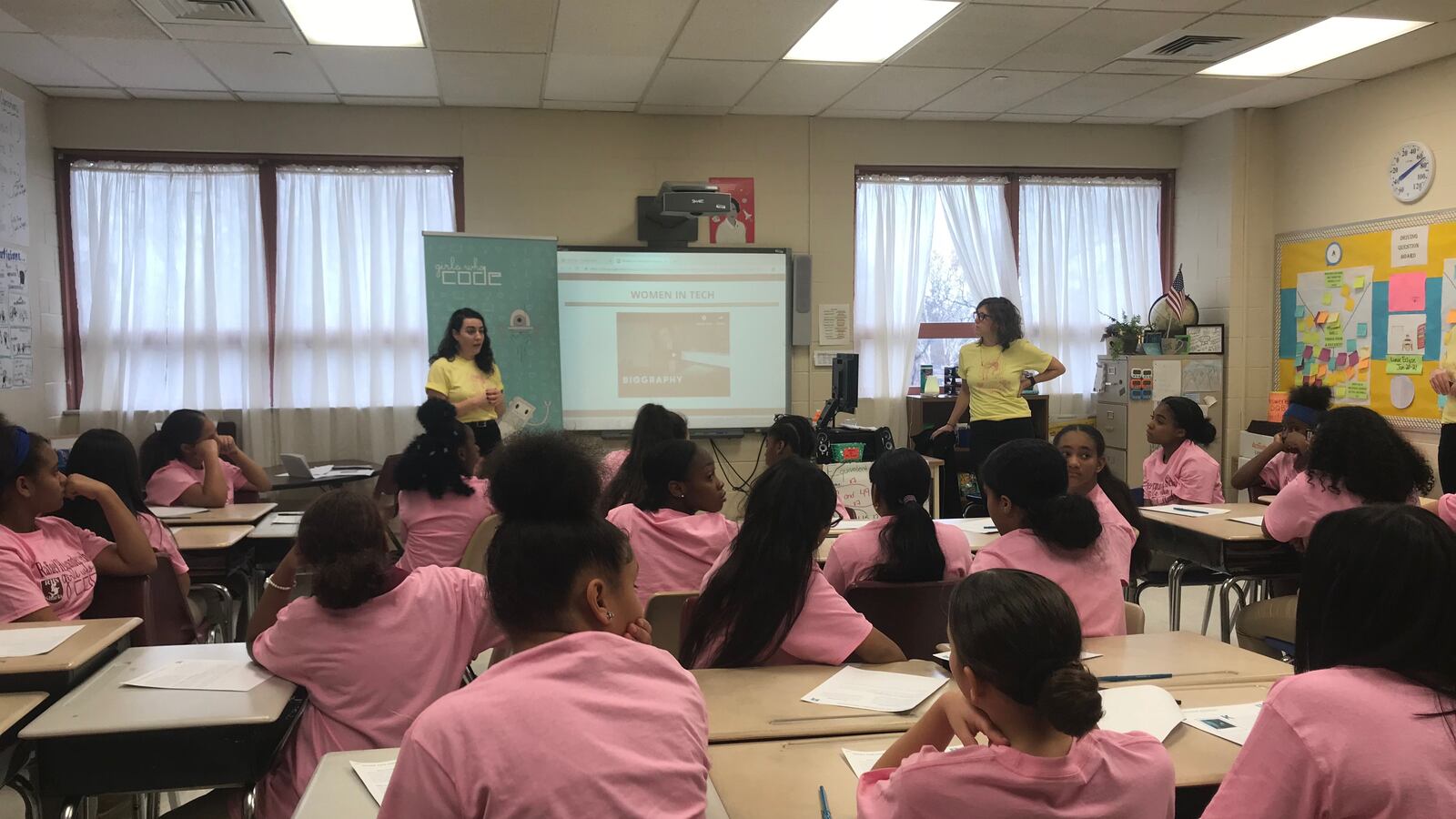Starting in the spring, more Newark middle schoolers will be learning how to code, owing to a new partnership between Newark Public Schools and Girls Who Code. Schools Superintendent Roger León announced the initiative at Rafael Hernandez Elementary School on Thursday. The partnership will establish Girls Who Code clubs in 24 of the district’s middle schools, providing an introduction to coding skills to more than 3,000 girls.
“If we are serious about equity and opportunity, especially when it comes to communities of color, we have to teach them how to code,” said Reshma Saujani, the CEO of Girls Who Code. “I think it’s an opportunity to reach the hardest-to-reach communities.”
The initiative complements a push to increase computer science education statewide. In January, New Jersey passed a law requiring every public high school, starting this fall, to offer a computer science class. And in October, Governor Murphy committed $2 million to increasing the number of public high schools making advanced computer science classes available to students. Priority consideration will be given to schools that receive Title I funds.
Girls Who Code already offers clubs in six Newark schools, according to its website: Newark Tech High School, East Side High School, Barringer High Schools, TEAM Academy, Hawkins Street School, and First Avenue. The new partnership will increase that number and target middle schools exclusively.
By age 15, girls have often lost interest in math, science or technological subjects, according to one report. The program wants girls “to act or think like a computer scientist,” said Chrissy Ziccarelli, the director of education at Girls Who Code.
It also hopes to inspire girls to enter technology-related fields. The U.S. Bureau of Labor projects that there will be approximately 4.6 million computing jobs nationwide by the year 2020 but not enough people with the skills to fill those jobs.
“A majority of our girls want to take another computer science class after they participate in a club,” Ziccarelli said. Alumni of the program are also more likely to major in computer science, she said.
The challenge for districts, however, isn’t just exposing students to computers, says Darrin Sharif, Executive Director of Newark Kids Code, another organization that provides extra-curricular enrichment programs for Newark students, but also showing them how to use them. The Thirteenth Avenue School has two computer labs, for example. Rather, schools struggle to find teachers who are trained in how to teach computer science.
“It’s not a digital divide, it is a digital use divide,” Sharif said.
According to a report by Code.org, universities in New Jersey only graduated three new teachers prepared to teach computer science in 2016. Because of the shortage in computer-science instructors, Girls Who Code will use volunteer facilitators, who are not required to have a technical background (and often do not). Their training consists of two, 15-minute videos to introduce the structure of the program.
The facilitators are then encouraged to learn alongside their female students by completing tutorials with them. The clubs in the new Newark Public Schools partnership will also have access to one club specialist, who has a technical background, whom facilitators can reach out to online or by phone for support.
Newark Kids Code is approaching the teacher shortage by working to tap more homegrown talent. “There is a lot of tech activity that is happening downtown, but there’s no connection to our schools at all. It may be a while before [NPS] can fill that gap,” Darrin Sharif said.
To compensate, Newark Kids Code recruits computer science students from New Jersey Institute of Technology. These NJIT student facilitators then use curriculum from Code.org to teach six-hour workshops to elementary school students every Saturday at the Urban League’s headquarters for ten weeks. Students learn to develop websites, animations, and games with HTML and Scratch.
Stephanie Burdel has been teaching coding at Hawkins Street Elementary School for almost two years and attends “training” at Newark Kids Code on Saturdays, where she assists students, some of whom attend Hawkins and can observe the NJIT student facilitators. Burdel uses the time to learn best practices for teaching coding to her own students.
“I get extra engagement with students and see what problems they come across in the Scratch program,” Burdel said. “I learn what to do when students have problems when they’re coding and speak with the facilitators if I have questions.”
Last week, Burdel’s kindergarten and first-grade students participated in an Hour of Code, a national event designed to encourage interest in coding. She was amazed by how engaged students were. Burdel believes that learning to code in school can help students build character and improve in other subjects.
“I especially love seeing the little ones sitting and talking through the problems together,” she said. “You don’t think they have the capability — especially with shorter attention spans. But they sat engaged the whole time and they loved it.”
Ana Quezada is one of Burdel’s students. She is 10 years old and sees herself becoming a programmer so she can understand computers to make them better.
“When I’m not able to figure something out on my own after ten minutes, I look around to see who can help me,” Ana said. “I ask them to explain it so I know how everything works.”
Kei-Sygh Thomas is a Newark-based journalist, who grew up and went to schools in the city.

